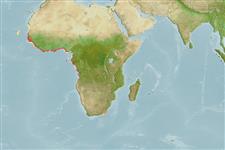分類 / Names
共通名の | 類義語 | Catalog of Fishes(部類, 種) | ITIS | CoL | WoRMS | Cloffa
板鰓亜鋼(サメとエイ類) (sharks and rays) >
Myliobatiformes (Stingrays) >
Dasyatidae (Stingrays) > Urogymninae
Etymology: margaritella: Named for the smaller size of this stingray and of its pearl (Latin: margarita) spine, as compared to Dasyatis margarita (Ref. 26277).
Eponymy: Margaritella is the diminutive of Margarita and is used to show this species is smaller than its relative (see Margarita above). The vernacular name is not only used to convey ‘Little Pearl’ but to reflect the fact that this species has a pearl spine. (Ref. 128868), visit book page.
More on authors: Compagno & Roberts.
Issue
Distribution will be corrected.
Environment: milieu / climate zone / 深さの範囲 / distribution range
生態学
海; 汽水性の 底生の; 深さの範囲 ? - 60 m (Ref. 114953). Tropical
Eastern Central Atlantic: West African coast from Cape Blanc in Mauritania to Angola (Ref. 7397, 81259, 81625, 114953). Often confused with Dasyatis margarita (Günther, 1870) (Ref. 7397).
サイズ / 重さ / 年齢
成熟: Lm ? range ? - ? cm
Max length : 30.0 cm WD オス/雌雄の選別がない; (Ref. 81259); 最大公表体重: 1.0 kg (Ref. 81259)
脊つい: 116 - 128. Diagnosis: Dasyatis margaritella is the smallest dasyatid in West Africa (Ref. 26277). It is most similar to Dasyatis margarita, which is larger and has a larger pearl spine, and more numerous pectoral radials, 133-135 vs. 116-127 in D. margaritella (Ref. 26277). It is also similar to D. garouaensis, which has a much flatter disc and a longer snout (Ref. 26277).
Body shape (shape guide): other; Cross section: flattened.
Dasyatis margaritella is the most common littoral stingray on the West African coast and it enter lagoons, shallow bays and estuaries (Ref. 7397, 81259). Most likely feeds on small invertebrates (Ref. 114953). Ovoviviparous (Ref. 50449).
Life cycle and mating behavior
成熟 | 繁殖 | 放精 | 卵 | 生産力 | 幼生
Exhibit ovoviparity (aplacental viviparity), with embryos feeding initially on yolk, then receiving additional nourishment from the mother by indirect absorption of uterine fluid enriched with mucus, fat or protein through specialised structures (Ref. 50449). Distinct pairing with embrace (Ref. 205).
Séret, B., 2003. Dasyatidae. p. 81-96. In D. Paugy, C. Lévêque and G.G Teugels (eds.) The fresh and brackish water fishes of West Africa Volume 1. Collection Faune et Flore Tropicales 40. Institut de recherche de développement, Paris, France, Muséum national d'histoire naturelle, Paris, France and Musée royal de l'Afrique Central, Tervuren, Belgium, 457p. (Ref. 81259)
IUCNのレッドリストの状況は (Ref. 130435: Version 2024-2)
Human uses
用具
特記事項
XMLをダウンロードして下さい
インターネットの情報源
Estimates based on models
Preferred temperature (参照
123201): 23.7 - 28, mean 26.6 °C (based on 66 cells).
Phylogenetic diversity index (参照
82804): PD
50 = 0.5156 [Uniqueness, from 0.5 = low to 2.0 = high].
Bayesian length-weight: a=0.01023 (0.00486 - 0.02155), b=3.06 (2.87 - 3.25), in cm total length, based on LWR estimates for this (Sub)family-body shape (Ref.
93245).
栄養段階 (参照
69278): 3.9 ±0.13 se; based on food items.
回復力 (参照
120179): 低い, 4.5年~14年の倍増期間の最小個体群 (Assuming fecundity<100).
Fishing Vulnerability (Ref.
59153): Very high vulnerability (90 of 100).
🛈
Nutrients (Ref.
124155): Calcium = 63.4 [13.9, 304.2] mg/100g; Iron = 0.84 [0.21, 2.38] mg/100g; Protein = 21.7 [18.8, 24.8] %; Omega3 = 0.222 [0.061, 0.662] g/100g; Selenium = 27.6 [8.0, 80.2] μg/100g; VitaminA = 34.4 [12.4, 91.8] μg/100g; Zinc = 1.38 [0.67, 2.66] mg/100g (wet weight);
